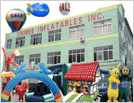Inflatable products have become increasingly popular due to their portability, versatility, and fun factor. From bouncy castles to inflatable kayaks, there is an inflatable product for almost every need. However, have you ever wondered how these inflatables are made? In this article, we will discuss the materials and manufacturing process of inflatable products and how to maintain product quality.
Materials Used for Inflatable Products
- PVC (Polyvinyl Chloride): PVC is a synthetic plastic material that is commonly used to make inflatable products. It is durable, lightweight, and water-resistant, making it an excellent choice for products like inflatable kayaks and boats.
- Nylon: Nylon is a lightweight and durable material that is commonly used to make inflatable products. It is flexible and resistant to tearing, making it an excellent choice for products like inflatable tents and bounce houses.
- TPU (Thermoplastic Polyurethane): TPU is a flexible and durable material that is commonly used to make inflatable products. It is resistant to abrasions and punctures, making it an excellent choice for products like inflatable air mattresses and loungers.
Manufacturing Process of Inflatable Products
- Design: The first step in the manufacturing process is designing the inflatable product. The design will determine the size, shape, and features of the product.
- Cutting and Stitching: The materials are then cut to size and stitched together. The stitching is done using a high-strength thread and a specialized sewing machine to ensure a strong and secure bond.
- Inflation: Once the product is stitched together, it is inflated to ensure that there are no leaks or punctures.
- Quality Control: After inflation, the product undergoes rigorous quality control checks to ensure that it meets the required standards. This includes checking for leaks, proper inflation, and overall product integrity.
Maintaining Product Quality
- Proper Storage: When not in use, inflatable products should be properly deflated and stored in a dry, cool place to prevent mold and mildew.
- Regular Cleaning: Inflatable products should be regularly cleaned with mild soap and water to prevent dirt and grime buildup.
- Avoid Sharp Objects: Inflatable products should be kept away from sharp objects that could puncture or damage the product.
- Repair Kits: Most inflatable products come with repair kits that should be used to patch any leaks or punctures immediately.
In conclusion, inflatable products are made from materials such as PVC, nylon, and TPU, and undergo a manufacturing process that involves design, cutting and stitching, inflation, and quality control. To maintain product quality, proper storage, regular cleaning, avoiding sharp objects, and using repair kits are essential. Understanding the materials and manufacturing process of inflatable products can help ensure that you get the most out of your inflatable products.


 About Us
About Us








